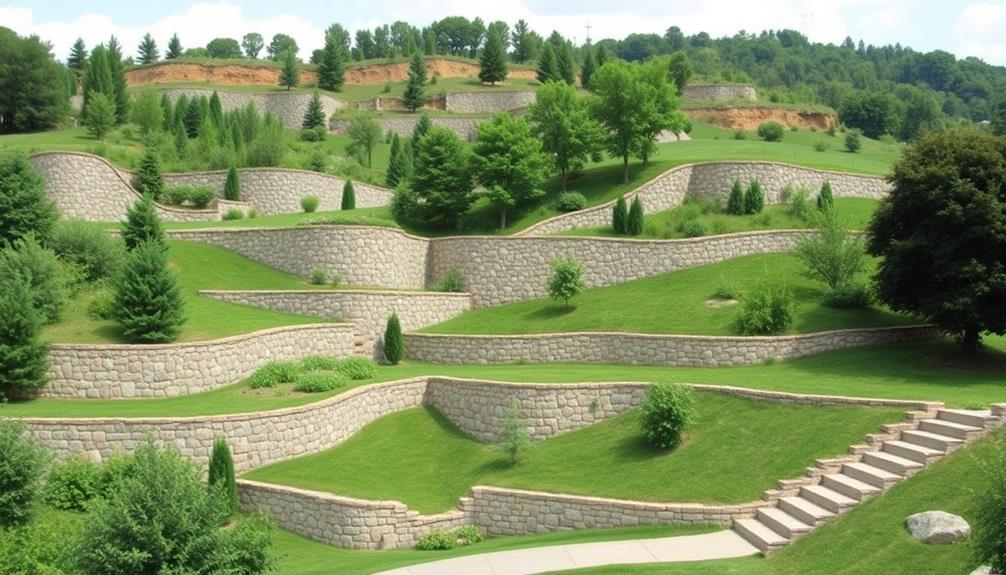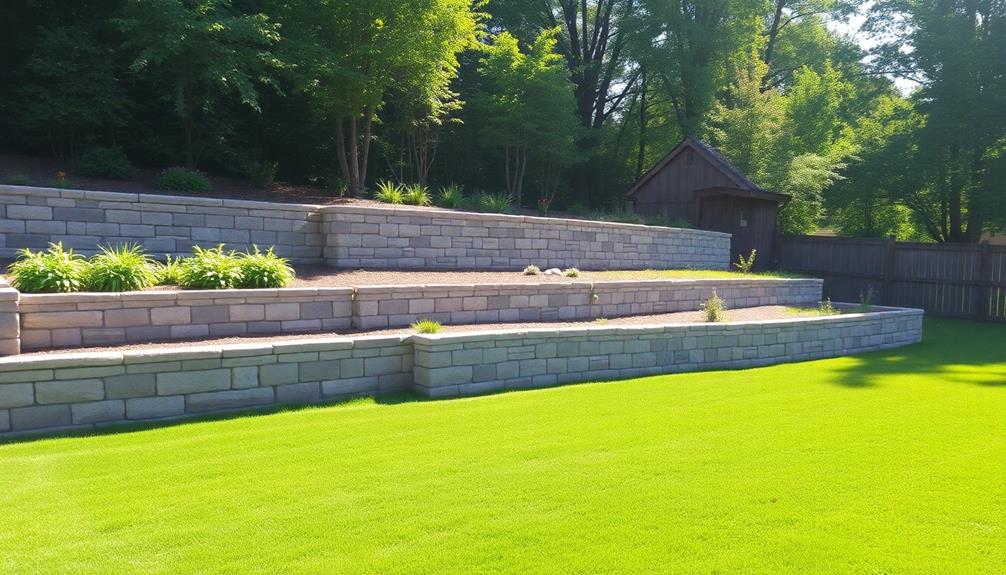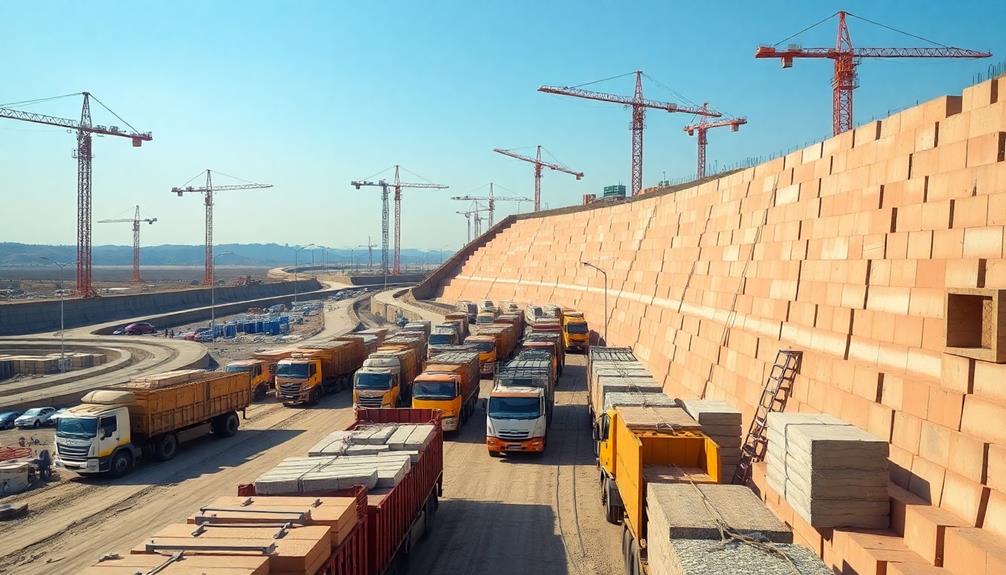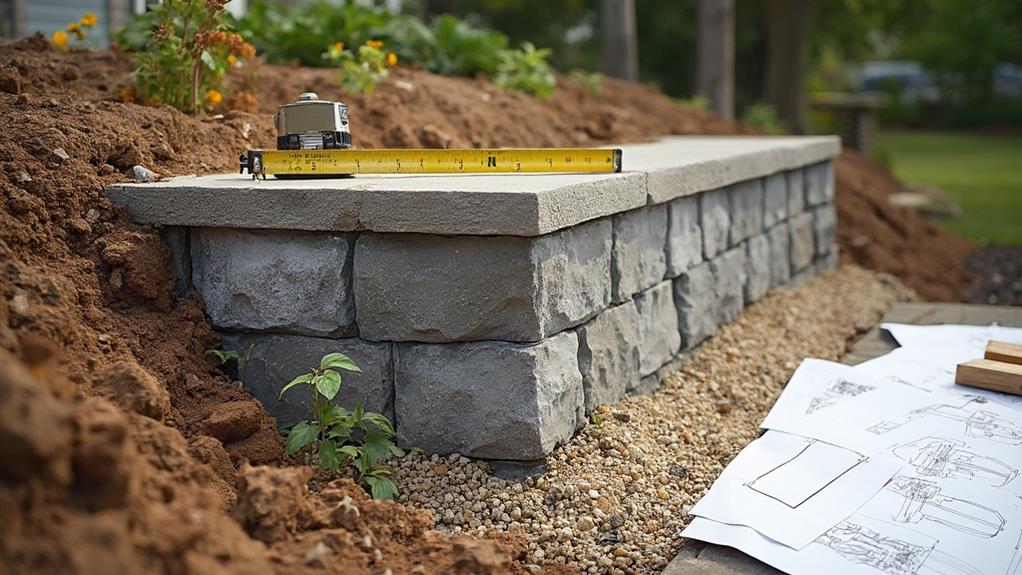To estimate the costs for retaining wall construction, carefully assess the impact of material selection, where stone and concrete provide longevity but higher initial costs, while timber may be cheaper initially. Factor in labor expenses, which include costs for excavation, construction, and installation of drainage systems, with skilled labor potentially ranging from $40 to $70 per hour. Consider site preparation, which involves soil and topographical assessments, as this can drive up costs due to specialized equipment needs. Transportation fees must account for distance, fuel, and possible surcharges. These elements will shape your understanding of the project's financial scope further.
Table of Contents
ToggleWalls Contractor Highlights
- Assess material selection based on durability, aesthetics, and availability to gauge initial and long-term costs accurately.
- Calculate labor expenses by considering rates for skilled workers, engineers, and the time required for specific tasks.
- Evaluate site preparation costs, including geological surveys, soil stabilization, and compliance with regulations.
- Factor in transportation expenses by considering fuel costs, surcharges, and potential for alternative shipping methods.
- Incorporate contingency margins to account for unanticipated labor inefficiencies or material price fluctuations.
Retaining Wall Cost Factors

Retaining wall construction costs are greatly influenced by a variety of key factors, among which material selection plays a pivotal role, as the choice of concrete, stone, timber, or other materials can both dictate the aesthetic and alter the budget. For instance, using boulders can be a long-term and cost-effective solution while providing a decorative extension of a home.
In addition to material costs, labor expenses must be carefully considered, encompassing not only the wages of skilled contractors but also potential overtime and project-specific labor requirements that may fluctuate based on complexity. Equally important is the need of site preparation, which involves grading, clearing, and any necessary modifications to guarantee the foundational stability of the wall, all of which contribute to the overall expense of the project.
Material Selection Impact
Choosing the right materials greatly influences the overall cost of building a retaining wall. The selection process involves considering factors such as durability, aesthetics, environmental compatibility, and initial cost.
Stone and concrete are popular choices for their robustness and long lifespan, though they may carry a higher upfront cost. Alternatively, materials like timber or brick offer aesthetic appeal and moderate durability but may require more maintenance over time, potentially escalating the long-term costs.
The decision on material types also intertwines with environmental factors, such as soil type and weather conditions, which dictate the necessary structural strength and longevity of the wall. Specific materials can enhance the design flexibility of a retaining wall, enabling homeowners and builders to integrate the structure seamlessly into existing landscapes. Additionally, the availability of materials locally can impact transportation costs, thereby influencing the overall budget.
Making informed material decisions can foster a sense of achievement and satisfaction within the community, as it accentuates commitment to quality and long-lasting solutions. Further contemplation on material impact facilitates a judicious choice, aligning financial planning with envisioned aesthetic and functional outcomes, ultimately enhancing property value and communal harmony.
Labor Expenses Breakdown
Understanding the labor expenses involved in retaining wall construction is crucial for effective budget planning. Labor costs encompass a range of professional services, each indispensable to ensuring the structural integrity and aesthetic appeal of your project. Typically, labor accounts for a significant portion of the overall expenses, reflecting the specialized skills required for tasks such as excavation, foundation preparation, wall construction, and the installation of drainage systems. Each stage of the process demands meticulous attention, usually provided by skilled masons, engineers, and general construction workers.
In outer and inner urban zones, labor rates often vary based on location and prevailing market conditions. Customary hourly rates for masons and skilled workers can fluctuate between $40 to $70, depending on experience and complexity, while engineers may require higher compensation for project oversight and site evaluation. Additionally, specific tasks like mortar application, stone setting, and reinforcement installation demand varying degrees of expertise and labor time, influencing final expenses substantially.
Including contingency margins for potential labor inefficiencies or overruns is prudent. Accurate estimates necessitate engaging with reputable contractors who provide a transparent breakdown of their labor pricing, enabling informed financial planning that aligns with your expectations and project's unique requirements.
Site Preparation Requirements
A thorough evaluation of site preparation requirements is essential in estimating the overall cost of constructing a retaining wall. The selection and treatment of the site form a foundational aspect of the project, dictating materials and techniques necessary for stability and longevity.
Site preparation involves multiple factors, including examining soil type, identifying potential drainage issues, and removing obstacles such as vegetation or existing structures. These elements are central to ensuring the structural integrity of the retaining wall and its effectiveness in managing land elevation or preventing erosion.
Accurate appraisal begins with a thorough geological survey, which will inform decisions on the depth and width of footings or if soil stabilization measures are necessary. Additionally, site accessibility can drastically affect cost and scheduling, as restricted access might necessitate special equipment or longer time frames to transport materials efficiently.
Understanding these requirements may also involve consultation with geotechnical engineers to anticipate challenges specific to the site's location, such as seismic activity or extreme weather conditions.
In preparing a site, project managers and contractors align strategies with community regulations and environmental considerations, reinforcing a shared commitment to sustainable and safe construction practices among all stakeholders involved.
Benefits

In addition to offering practical solutions to landscape challenges, retaining walls provide significant benefits that justify their construction costs. These structures enhance property value by creating usable space and can also add aesthetic appeal to a landscape, making it more attractive and organized.
Retaining walls like boulder walls offer a sustainable and eco-friendly solution due to their minimal maintenance requirements and natural design. Additionally, retaining walls serve critical functions in preventing soil erosion and increasing the structural stability of properties, ensuring long-term environmental and infrastructural integrity.
Enhances Property Value
Constructing a retaining wall can profoundly enhance property value, offering both functional and aesthetic benefits that appeal to prospective buyers. By bolstering the structural integrity of outdoor spaces, these constructions contribute to the safety and usability of the landscape, making properties more appealing to those looking for permanence and resilience.
The visual allure of a well-constructed retaining wall can also elevate the overall aesthetic, providing a distinguished appearance to the exterior environment.
Specific advantages of a retaining wall in property valuation include:
- Landscaping Potential: By creating flat, usable spaces on sloped areas, retaining walls enable creative landscaping options, allowing homeowners to implement gardens or terraces, which adds an immediate visual and practical dimension to the property.
- Increased Usable Space: Transforming uneven terrain into valuable real estate enhances the functionality of previously unusable areas, offering greater flexibility in property usage and increasing its intrinsic value.
- Curb Appeal: A professionally designed retaining wall adds a polished, groomed appearance, enhancing the initial impression of a property, thereby appealing to discerning buyers and fostering a sense of belonging.
These elements contribute greatly to both the immediate enjoyment of the property and its long-term marketability.
Prevents Soil Erosion
While enhancing property value remains a significant advantage, retaining walls also play a pivotal role in preventing soil erosion. By steadfastly holding back soil, these structures shield your landscape from erosion's often unpredictable and damaging effects.
Retaining walls are engineered to stabilize slopes and create secure, level surfaces in areas with varying topography, guaranteeing that adjacent land areas remain intact and functional. This is particularly essential in preserving the integrity of landscapes on properties that have been developed on hills or modified terrains, where soil integrity can be vulnerable to natural elements like water and wind.
Moreover, these functional barriers offer a tangible solution for communities that share a commitment to environmental responsibility. By reducing runoff velocity, retaining walls provide essential support in reducing sedimentation in nearby water bodies, thereby contributing to overall watershed health. This controlled earth management instills a sense of shared environmental stewardship, fostering community pride and cohesion.
In essence, retaining walls do not merely serve as separators of earth and architectural features; they are pivotal guardians of the very soil upon which communities and environments depend. Their ability to preserve and protect soil integrity guarantees that the landscapes you cherish remain enduring foundations for engagement and connection.
Boosts Landscape Aesthetics
A well-designed retaining wall can considerably enhance the aesthetics of a landscape, transforming it into an eye-catching feature that harmonizes with the surrounding environment. Not merely a functional structure, a retaining wall offers an elegant solution that contributes to the overall visual appeal of a property. Its thoughtful design can blend with natural elements, adding value and charm, and ultimately fostering a sense of belonging among residents and visitors.
To truly elevate your landscape's aesthetic, consider these three key design elements:
- Material Selection: Choosing materials that match or complement existing architectural elements can create a cohesive look. Options like natural stone, brick, or concrete blocks each provide distinct finishes that suit various stylistic preferences.
- Incorporation of Greenery: Integrating plants and greenery into the retaining wall design can soften sharp edges and introduce vibrant textures that resonate with the natural surroundings.
- Artistic Design Features: Incorporating curves, tiered levels, or decorative patterns not only maximizes functionality but also adds artistic dimension to the landscape, making the space inviting and engaging.
Increases Structural Stability
Enhancing structural stability is one of the primary benefits of installing a retaining wall, particularly on sloped terrains. Such constructions are engineered to safeguard against soil erosion, which can compromise land integrity over time. By anchoring the soil behind them, retaining walls minimize the risk of landslides and ground subsidence, thereby maintaining the topography's intended layout and preserving the safety of nearby structures. This protective measure is especially critical for properties where elevation changes might otherwise pose hazards, allowing for the secure use of space that might have been deemed too risky without such reinforcements.
Retaining walls also distribute lateral pressure efficiently, reducing stress on foundational elements of adjoining infrastructures. The balance between aesthetics and utility is achieved through meticulous design, where the walls not only offer a means of stability but also blend seamlessly with the natural landscape. Utilization of durable materials, such as concrete, stone, or timber, guarantees long-term resilience against environmental forces like water flow and seismic activity. Investing in such robust foundations speaks to a community's commitment to safety and stability, fostering a sense of belonging among residents who value both beauty and practicality.
Material Transportation Expenses

Understanding the intricacies of material transportation expenses requires considering several key factors, including the distance over which materials must be moved and the associated delivery fees, as well as the type and capacity of vehicles utilized. These elements, along with fluctuating fuel costs and potential surcharges, considerably influence the overall cost structure of retaining wall construction projects. The following table breakdown exemplifies some typical cost considerations:
| Factor | Cost Consideration |
|---|---|
| Distance and Delivery Fees | Variable by mileage |
| Vehicle Type and Capacity | Larger capacity, higher cost |
| Fuel Costs | Subject to market prices |
| Surcharges | Seasonal or regional |
| Total Transportation Cost | Sum of all factors |
Distance and Delivery Fees
Material transportation expenses, particularly distance and delivery fees, substantially influence the overall cost of constructing a retaining wall. As the location of your project becomes more remote from the material source, anticipated fees for transportation logistically increase, impacting the budget. Understanding this nuanced aspect of cost estimation is essential for accurately projecting your financial commitments and guaranteeing a successful construction process.
Proximity to Suppliers: The closer a project site is to suppliers of materials such as stone, concrete, and lumber, the lower the transportation fees are likely to be. Establishing partnerships with local suppliers can mitigate these costs significantly, fostering a seamless integration of resources.
Local Regulations and Restrictions: Delivery fees may also reflect local restrictions on vehicle size or weight, as well as peak and off-peak traffic hours within urban areas. Maneuvering these restrictions with careful planning can prevent unexpected expenses and ensure timely delivery.
Geographic Challenges: Natural geographical barriers such as rivers, mountains, or limited road infrastructure may necessitate indirect routes, thereby increasing distance and delivery costs. Evaluating available routes for efficiency can reduce unnecessary expenses and improve the project's operational flow.
Vehicle Type and Capacity
The selection of vehicle type and its capacity are pivotal factors in determining transportation expenses for a retaining wall project. Choosing the appropriate vehicle can drastically impact the logistics and cost-efficiency associated with material transportation.
Larger vehicles, such as flatbed trucks or semi-trailers, boast high payload capacities, allowing the transport of substantial material volumes in fewer trips, thus minimizing expenses associated with labor and time. Meanwhile, smaller vehicles, like pickups or small dump trucks, may necessitate multiple trips, potentially elevating overall costs due to increased driver hours and vehicle wear.
When evaluating vehicle options, consider the specific material requirements of your retaining wall project. For instance, transporting heavy materials like concrete blocks or boulders may exceed the capacity of smaller vehicles, necessitating larger options. In contrast, projects dealing with lighter materials might benefit from smaller, more fuel-efficient vehicles. Additionally, account for accessibility challenges of the construction site, as certain vehicles might be better suited to maneuvering tight or uneven terrains.
Ultimately, selecting an appropriate vehicle type and capacity not only optimizes material transport efficiency but also fosters a sense of professionalism and competence in project execution, strengthening your role within the community of proficient contractors.
Fuel Costs and Surcharges
Fuel costs and surcharges represent significant components of material transportation expenses in retaining wall projects. As fuel prices fluctuate due to market dynamics and geopolitical considerations, these costs can substantially affect project budgets, making an understanding of them indispensable to accurate cost estimation.
Furthermore, surcharges—additional fees imposed by suppliers to offset fluctuations or other operational costs—require careful consideration.
To provide a clearer picture of how these expenses can be managed and predicted, focus on the following key factors:
- Fluctuating Fuel Prices: An in-depth analysis of historical and current fuel prices is vital. Monitoring these trends allows for more accurate forecasting and budgeting, ensuring that cost estimates remain realistic over the duration of the project.
- Supplier Surcharges: Engage in contracts and negotiations with suppliers to understand and potentially mitigate these costs. Transparent discussions can lead to agreements that factor in potential surcharges intelligently, allowing for adaptable project planning.
- Alternative Transportation Methods: Investigate the feasibility of alternative fuel options or shared transport services, which can sometimes offer cost advantages over traditional methods, especially where sustainable practices are prioritized by stakeholders.
Walls Contractor FAQ
What Permits Are Needed for Retaining Wall Construction?
Permits for retaining wall construction depend on local regulations, often requiring zoning approval and building permits. It's crucial to consult municipal guidelines to guarantee compliance, fostering community trust and promoting harmonious development within shared spaces.
How Do I Determine the Height of My Retaining Wall?
Determining the height of your retaining wall involves evaluating the soil type, slope gradient, and load-bearing requirements. Consulting with a structural engineer guarantees compliance with local regulations, providing confidence and a sense of belonging in the construction community.
Are There Specific Local Regulations for Retaining Walls?
Determining local regulations for retaining walls is vital, as adherence safeguards both safety and project authenticity. Connecting with community planning offices fosters a sense of belonging and aids in understanding specific codes, permits, and zoning restrictions.
How Can I Ensure Proper Drainage for My Retaining Wall?
Ensuring proper drainage for your retaining wall involves installing a perforated pipe system behind the wall, using gravel backfill, and incorporating weep holes. This fosters long-term structural integrity and aligns your project with best engineering practices.
What Are Common Mistakes to Avoid During Retaining Wall Installation?
During retaining wall installation, common mistakes include inadequate drainage systems, improper foundation preparation, using incorrect materials, and ignoring soil conditions. Ensuring professional guidance and adherence to design specifications enhances stability and durability, fostering a sense of security and community trust.







